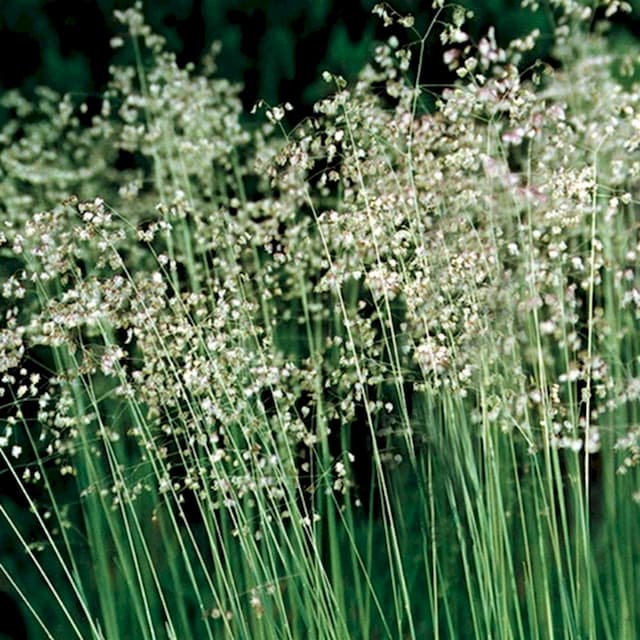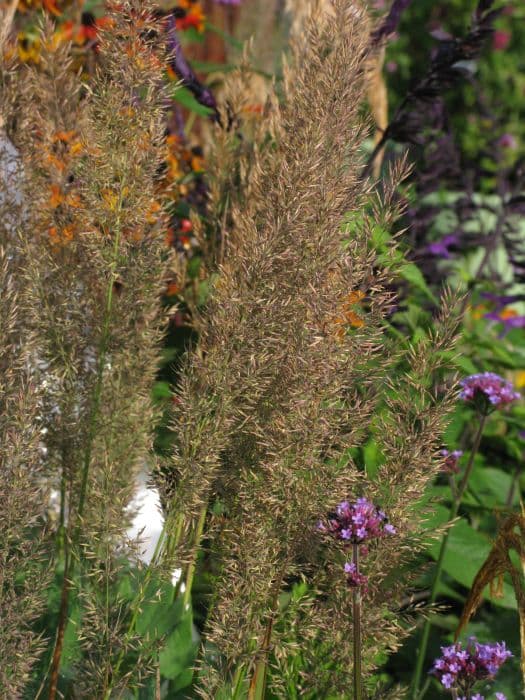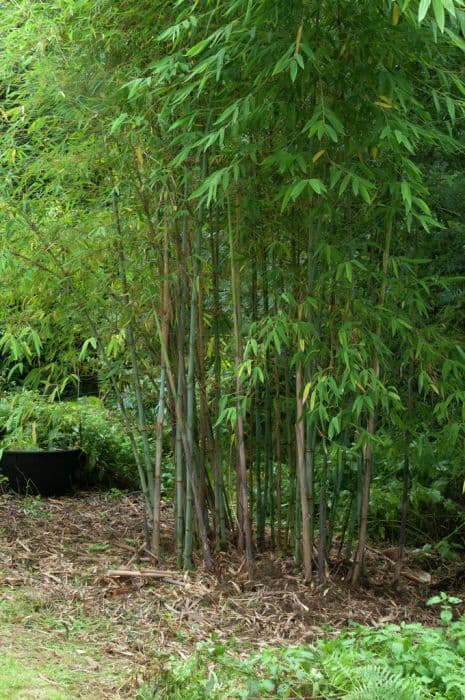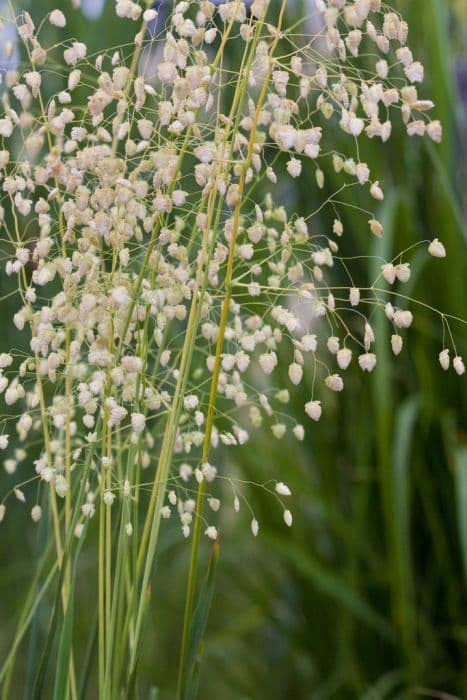Purple moor-grass 'Strahlenquelle' Molinia caerulea subsp. caerulea 'Strahlenquelle'











ABOUT
'Strahlenquelle' is a tufted perennial grass up to 90cm high, with clumps of green leaves which turn golden yellow in autumn, and arching flower stems of bronze flowers from summer to autumn, followed by seedheads which remain attractive in winter
About this plant
 Names
NamesFamily
Poaceae
Synonyms
Purple Moor Grass, Moor Grass
Common names
Molinia caerulea subsp. caerulea 'Strahlenquelle'.
 Characteristics
CharacteristicsLife cycle
Perennials
Foliage type
Deciduous
Color of leaves
Green
Flower color
Purple
Height
2-3 feet (60-90 cm)
Spread
1-2 feet (30-60 cm)
Plant type
Herb
Hardiness zones
5
Native area
Europe
Benefits
 General Benefits
General Benefits- Ornamental Value: Molinia caerulea, commonly known as Purple Moor Grass, adds aesthetic appeal to gardens with its attractive foliage and airy flower panicles.
- Low Maintenance: It is known for being easy to care for, requiring minimal upkeep once established.
- Tolerant of Various Soils: Purple Moor Grass adapts to a range of soil types, although it prefers moist, acidic conditions.
- Pest Resistance: It generally has good resistance to pests and diseases, reducing the need for chemical treatments.
- Wildlife Support: Its seed heads provide food for birds, and the plant can offer habitat for insects and small wildlife.
- Seasonal Interest: This subspecies has seasonal interest with foliage that changes color in the autumn, providing an attractive display late in the year.
- Structural Element: The upright form and texture of Purple Moor Grass can be used to create structure and contrast in landscape design.
- Erosion Control: It can be effective in stabilizing soil and controlling erosion, especially in moist environments.
 Medical Properties
Medical PropertiesThis plant is not used for medical purposes.
 Air-purifying Qualities
Air-purifying QualitiesThis plant is not specifically known for air purifying qualities.
 Other Uses
Other Uses- Craft Material: The dried stems of Purple Moor Grass can be used in weaving or as a natural material for DIY crafting projects, creating baskets, mats, or decorative art pieces.
- Animal Bedding: The grass can be harvested, dried, and used as bedding for small animals such as rabbits and guinea pigs due to its absorbent nature.
- Natural Dye: The leaves and stems can be used to produce a natural dye for fabrics, offering a range of colors depending on the mordant used.
- Thatching Material: Traditional thatching methods can utilize Purple Moor Grass as a material for roofing small structures such as garden sheds or huts.
- Acoustic Insulation: Bundles of the dried grasses can be implemented as a natural acoustic insulator in construction or in sound-sensitive environments.
- Landscape Photography: The wispy and dynamic form of Purple Moor Grass is ideal for adding texture and interest in landscape photography, especially in the autumn.
- Education: The plant can be part of botanical studies and educational programs aimed at teaching plant identification and the ecological significance of native grasses.
- Erosion Control: This deep-rooted grass can be planted on slopes and banks to help stabilize soil and prevent erosion.
- Garden Sculptures: When dried, the grass can be manipulated into shapes and used as a component in garden sculptures or outdoor installations.
- Biomass Production: Purple Moor Grass can be harvested and used as a source of biomass for renewable energy production, although on a very small and local scale.
Interesting Facts
 Feng Shui
Feng ShuiThe plant Molinia is not used in Feng Shui practice.
 Zodiac Sign Compitability
Zodiac Sign CompitabilityThe plant Molinia is not used in astrology practice.
 Plant Symbolism
Plant Symbolism- Adaptability - Molinia caerulea, commonly known as Purple Moor-grass, demonstrates adaptability by thriving in both acidic and neutral soils, showcasing its resilience in various environments.
- Resilience - Purple Moor-grass symbolizes resilience as it can tolerate and adapt to harsh conditions like waterlogged soils, a trait that makes it a survivor in difficult terrains.
- Growth - The upward growth habit of the grass reflects the symbolic meaning of growth and reaching for higher aspirations.
- Balance - With its fine foliage and airy flower spikes, Purple Moor-grass represents a balance between form and movement, symbolizing equilibrium in life.
- Simplicity - The clean lines and unassuming appearance of the grass signifies simplicity and an appreciation for the minimalist approach in life.
 Water
WaterFor the Purple Moor Grass (Molinia caerulea 'Strahlenquelle'), a consistent watering schedule is integral to its health. Thoroughly water the plant weekly with about 1-2 inches of water, ensuring the soil remains moist but not waterlogged. During the growing season, increase the frequency to twice a week if the weather is particularly dry or hot. In the winter, reduce watering to every other week, but make sure the soil doesn't dry out completely. Adjust these guidelines depending on rainfall and always check the top inch of the soil for dryness before watering.
 Light
LightPurple Moor Grass (Molinia caerulea 'Strahlenquelle') favors full sun to part shade conditions. Ideal placement is in an area where the plant can receive at least 6 hours of direct sunlight daily; however, it can tolerate some light afternoon shade, which can be beneficial in very hot climates. Avoid deep shade areas, as insufficient light could impede the grass's growth and reduce the vibrancy of its foliage.
 Temperature
TemperaturePurple Moor Grass (Molinia caerulea 'Strahlenquelle') prefers temperate climates and can withstand seasonal fluctuations well. It flourishes in temperatures ranging between 40 and 80 degrees Fahrenheit but can survive brief periods outside this range. However, prolonged exposure to temperatures below 20 degrees Fahrenheit could be damaging to the plant, and extreme heat above 90 degrees Fahrenheit might also require additional care such as increased watering.
 Pruning
PruningPruning Purple Moor Grass (Molinia caerulea 'Strahlenquelle') is best done in late winter or early spring before new growth starts. This involves cutting back the previous year's foliage to about 3-4 inches above the ground to encourage fresh growth. Pruning annually helps maintain an attractive shape and removes any dead or damaged leaves that have accumulated through the season.
 Cleaning
CleaningAs needed
 Soil
SoilPurple Moor Grass prefers a soil mix that is moist but well-draining, with an acidic to neutral pH range of 5.0 to 7.0. A mixture of loam, peat, and sand can create suitable conditions for this grass.
 Repotting
RepottingPurple Moor Grass does not require frequent repotting and can thrive without being disturbed for several years. Repotting every 3 to 4 years is sufficient unless the plant outgrows its container.
 Humidity & Misting
Humidity & MistingPurple Moor Grass tolerates a wide range of humidity levels but prefers conditions that mimic its natural boggy and moist habitats, without the need for high humidity maintenance.
 Suitable locations
Suitable locationsIndoor
Provide bright light and maintain moist soil.
Outdoor
Plant in full sun to partial shade in moist soil.
Hardiness zone
4-9 USDA
 Life cycle
Life cycleMolinia caerulea subsp. caerulea 'Strahlenquelle', commonly known as Purple Moor Grass, begins its life cycle as a seed, which germinates in late spring when the soil warms. The seedling then develops into a clumping perennial grass, establishing a strong root system and producing narrow, linear leaves. During the summer, it enters the flowering stage, sending up tall, airy flowering stalks that can add visual interest to the landscape. After pollination, typically by wind, the plant sets seed in late summer or early fall. As a perennial, after the growing season, the foliage and flower stalks die back to the ground in winter, but the roots remain alive and dormant. In the following spring, the plant regrows from its rootstock, completing the cycle and beginning again with new growth.
 Propogation
PropogationPropogation time
Spring to Summer
Propogation: Molinia caerulea subsp. caerulea 'Strahlenquelle', commonly known as the Purple Moor Grass 'Strahlenquelle', is best propagated through division. The ideal time to propagate this grass is in the spring, as the plants begin to show new growth from their root systems. To divide the plant, you will need to dig up the entire clump and carefully split it into smaller sections, ensuring that each section has a portion of the root system attached. It's recommended to use a sharp spade or knife to make the divisions, and then replant the new divisions immediately, at the same depth as the original plant was growing. Make sure to water the new plants thoroughly after planting to help establish them. Division helps to rejuvenate older clumps that may become less vigorous over time and is also a quick way to increase the number of plants in your garden.









